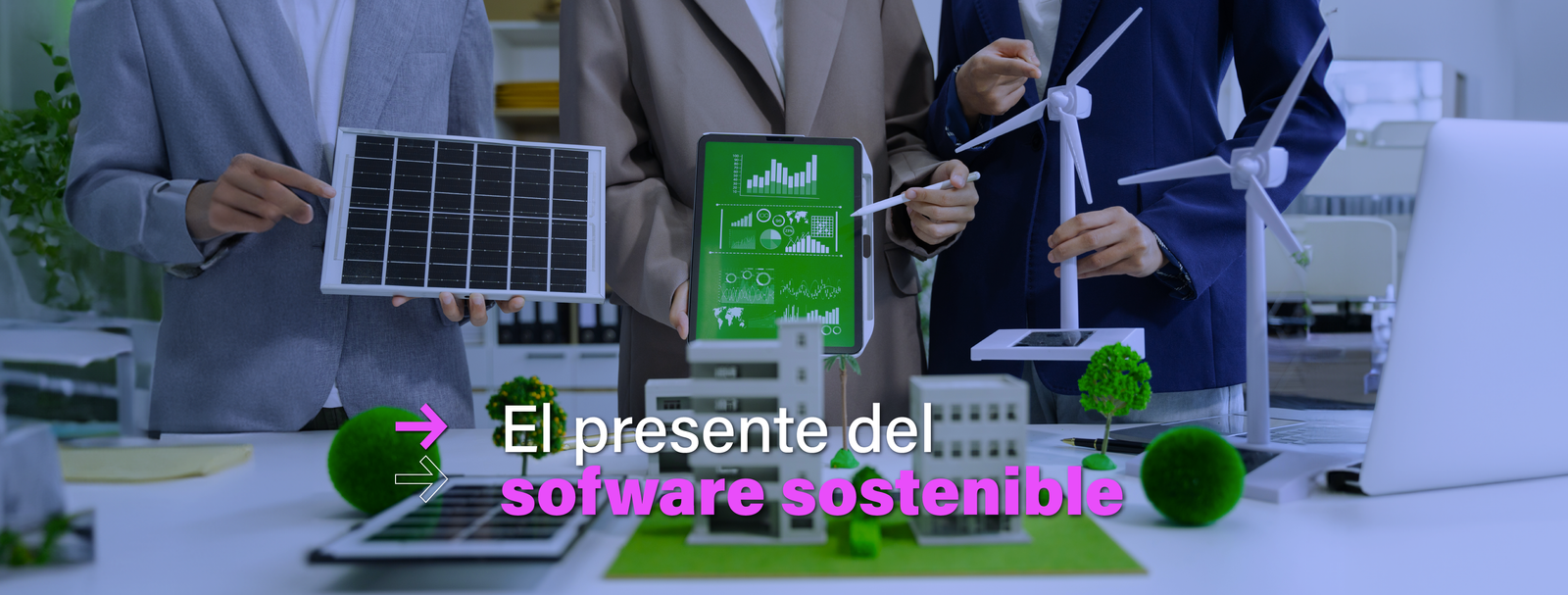Sustainable software: the impact of a trend that is consolidating in the IT industry
In a world where digital transformation is growing at a constant pace, with the incorporation of technology in all productive and transactional processes, Sustainability emerges as a critical factor for the conservation and protection of the environment.
The interesting thing is that sustainable software represents a dual vision:
- Recognizes that technological development can be part of the problem, if not managed responsibly.
- It is positioned as an innovative and transformative solution to the socio-environmental challenges we currently face.
Taking this approach is not just an option. It is a responsibility to ensure a more sustainable and equitable future..
In this article we analyze What does the concept of sustainable software entail? and what are its main characteristics, good practices and advantages.
Likewise, we address its relationship with the reduction of the ecological footprint and we investigate the Emerging technologies key to advancing towards sustainability.
In addition, we evaluate How to measure software sustainability and what its future holds.
What is sustainable software?
Sustainable software is defined as the development of technological solutions that, from their conception, design, implementation and operation, seek to minimize negative impacts on the environment and society, while maximizing their positive contribution to these areas.
This approach not only considers energy efficiency and responsible use of resources during the software life cycle.
It also integrates ethical, inclusion and equity principles, with the aim of addressing socio-environmental problems and promoting fairer and more sustainable development.
Why is sustainable software relevant today?
The relevance of sustainable software today is undeniable, in a context of global climate crisis, where environmental indicators show accelerated deterioration, and social and economic gaps persist or widen.
Added to this is the central role that the technology industry has acquired in recent years, driven by digital transformation and massive migration towards digitalized processes.
A growth that brought with it a significant increase in energy consumption, the generation of electronic waste and the demand for natural resources.
All of these are factors that make the technology sector a key player in terms of global environmental footprint.
It is an industry that also has the potential to be a powerful tool to meet these challenges.
From this perspective, sustainable software emerges as a response to the need for Aligning technological development with sustainability principles.
Not only through optimising the energy performance of applications and systems, but also through the design of solutions that promote digital inclusion, reduce inequalities and facilitate the transition towards more sustainable economic and social models.
What are the main characteristics of sustainable software?
From IT Patagonia We believe that, in environmental terms, sustainable software is based on take the least amount of resources necessary for a development to provide the desired solution.
In this sense, using energy more intelligently means consuming sources with low carbon emissions and using them as efficiently as possible.
The aim is to accelerate the energy transition towards a low-carbon future.
From an inclusive perspective, the main aspect of sustainable software is its ability to adapt to a wide range of audiences, to overcome barriers and expand the scope of each solution.
The main aspects of sustainable software include:
- Energy efficiency: with a design aimed at consuming the least amount of energy possible, through algorithms and optimization techniques that allow reducing its carbon footprint.
- Use of resources: ability to operate with the least amount of physical and digital resources possible, in order to minimize the use of memory, processing and storage.
- Renewable energy sources: harnessing renewable energy sources, such as solar or wind energy, and reducing dependence on non-renewable energy sources.
- Accessible design: design thought for people with disabilities, using assistive technologies and following accessibility guidelines.
- Adaptability: ability to adapt to different environments and devices, to ensure that it is accessible to a wide variety of users.
- Life cycle: develop the solution so that it has a long life cycle, and does not need to be replaced or updated frequently.

Practices and principles for developing sustainable software
Sustainable software is based on measure and improve the impact of each development, through the interaction between three fundamental pillars:
- The codeMeasuring the environmental impact generated by each programming language, along with its pros and cons, at the time of optimization and compilation, is essential to raise awareness and improve sustainability levels.
- The infrastructure. Since this is the area where energy consumption is generated, it is crucial to know the composition of the hardware, in search of a balance between the necessary power and energy efficiency. Likewise, it is essential to consider the type of energy used, in order to prioritize renewable or low-emission sources.
- People. It is important for development teams to be trained in concepts of performance and digital accessibility, while user habits will determine much of the impact that the solution will have.
Sustainable software is not just a matter of green code.
It is a holistic approach that encompasses the efficiency of code, infrastructure and people behavior. Three factors that must be measured and continuously improved to generate digital solutions with less impact on the planet.
What are the benefits of sustainable software?
The advantages are multiple and cover the entire spectrum of the so-called triple environmental, social and economic impact.
By optimizing the use of resources, reducing environmental impact is one of the Main benefits of sustainable software.
From there, other advantages arise, such as long-term cost savings due to reduced energy consumption.
Another positive aspect is that consuming energy and resources in a more environmentally friendly way is becoming a rapidly growing trend globally.
This is why focusing on developments in a sustainable way allows us to position ourselves in a market that is increasingly aware of the environment. In this way, Software factories can stand out from the competition and reduce barriers to entry towards stricter markets, such as the European one.
At the organizational level, Sustainable software helps attract talented people, in a labour market where people value companies that work on environmental and social issues. Without a doubt, this type of commitment strengthens the employer brand.
Relationship between sustainable software and reducing the ecological footprint
Software is a very important part of every company's operations, from technology industries to more traditional companies.
Today, digital transformation is growing in organizations and as a result, the The weight that software and technological infrastructure have on the carbon footprint of each productive sector.
While infrastructure is a much more visible element of the chain when it comes to measuring the footprint of each organization, software must also be monitored despite being an intangible and highly invisible resource.
Even more so, when the IT industry is responsible for 41% of carbon emissions worldwide (The Shift Project Report).
That is why at IT Patagonia we talk about new layers of impact, which allow us to address all activities transversally.

Emerging technologies key to advancing sustainable development
Technologies applied to the IT industry have the potential to Driving the transition to a more sustainable world.
In this context, artificial intelligence emerges as a fundamental tool, which stands out for its capacity for automation and deep data analysis.
In effect, AI is configured as a Strategic ally to accelerate the development of sustainable solutions.
From the analysis of large volumes of information to the creation of resource optimization algorithms, this technology allows:
- Automate environmental monitoring.
- Generate practical knowledge that can feed and enhance other technological innovations.
Its power lies in the ability to Transforming complex data into actionable insights, to facilitate more efficient and responsible decision-making in various sectors, from energy management to urban planning and the conservation of natural resources, among others.
How to measure software sustainability?
Measuring the impact of a technological development involves an analysis of the design, development and delivery of the software applications involved, with various impacts on each of the profiles that form part of the process:
- For the programming area, it involves writing energy-efficient code.
- For the artificial intelligence and machine learning (AI/ML) development sector, it contemplates the use of previously trained models and the exploitation of optimized hardware.
- For database engineering, it covers decisions such as storage selection and query optimization.
To contribute to this process, the Green Software Foundation developed the Carbon Intensity (SCI) Software specifications, which today constitute an ISO standard for measuring the environmental impact of software.
According to these specifications, the steps to measure software emissions are as follows:
- Decide on the limits of the software, on the components to include.
- Choose the functional unit that best describes how the application scales, keeping in mind that the SCI is a rate that calculates carbon emissions per functional unit.
- Define for each component listed in the software boundaries, the quantification method.
- Calculate a rate for each software component, considering that the SCI value of the entire application is the sum of the SCI values of each software component in the system.
- Produce a report that reveals the SCI score, software limits, and calculation methodology.

Trends for sustainable software development
According to the IBM report Sustainability trends: five things to consider in 2024In the pursuit of net zero or net zero emissions, organizations will focus their sustainability efforts on two avenues by 2024: Clean energy and sustainable supply chains.
The report also highlights that the Corporate Sustainability Reporting Directive (CSRD) of the European Union, requires companies in Europe and other countries to produce annual reports on the environmental and social impact of their business activities.
From IEBS, the Business School of Innovation and Entrepreneurs, we analyze the 13 Biggest Tech Trends for 2025, among which green technology stands out as a global priority.
In this sense, sustainability is an imperative and More energy-efficient computing technologies are gaining prominence.
What is the future of sustainable software?
Sustainable software is destined to take center stage, leaving behind its perception as a niche or secondary concern.
The urgency of the climate crisis, growing social awareness and long-term economic benefits are driving this transition.
A significant cultural shift is coming to the software development industry. So much so that Sustainability will become a fundamental aspect for software development, along with performance, security and functionality.
Society, increasingly aware of the environmental impact, will require that computer developments be efficient in the use of energy and material resources.
In this context, companies and development teams will have to respond to this demand, with transparent information on the environmental footprint of their products.
This trend will mark a new era in which technology and sustainability will go hand in hand to ensure a greener and more responsible future.
Conclusion: How to balance technological innovation and sustainability?
The key is to include sustainability as a principle of innovation when starting a development, based on the fact that software can also be a facilitator of socio-environmental solutions.
Balancing technological innovation with sustainability requires a shift in mindset and the adoption of a holistic approach that considers environmental, social and economic impacts throughout the entire development lifecycle.
It's not about sacrificing innovation, but about finding creative ways to innovate more responsibly and efficiently.
At IT Patagonia, we are clear that We are not indifferent to the way we do business. Contact us to find out How we help organizations build usable, accessible, and sustainable products.

